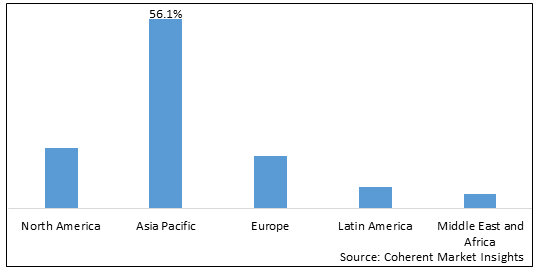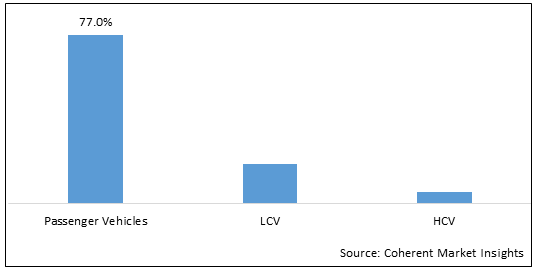Automotive Wire And Cable Materials Market is estimated to be valued at USD 5,592.8 Mn in 2025 and is expected to reach USD 8,691.1 Mn in 2032, exhibiting a compound annual growth rate (CAGR) of 6.5% from 2025 to 2032. Automotive wire and cable materials play a crucial role in the functioning and performance of various electrical and electronic components within automobiles.The automotive industry is constantly evolving, with advancements in technology and the increasing demand for electric and hybrid vehicles. As a result, the demand for high-quality wire and cable materials that can withstand the rigorous requirements of the automotive sector is also growing.
Automotive Wire And Cable Materials Market: Regional Insights
Figure 1: Automotive Wire And Cable Materials Market Share (%), By Region, 2025

To learn more about this report, Download Free Sample
The Asia-Pacific region has emerged as the dominant force in the automotive wire and cable materials market, capturing a market share of up to 56.1% in 2025. This strong position can be attributed to the region's thriving end-use industries, including appliances, automobiles, and electronics, among others. The demand in the Asia-Pacific region is further fueled by a growing emphasis on safety, functionality, and the implementation of vehicle safety regulations. China, in particular, experienced a notable 4.4% year-on-year increase in passenger car sales, reaching 20.15 million units in 2022, largely driven by the high demand for new energy vehicles (NEVs). Recognizing the immense potential, international wiring harness manufacturers are actively entering the Chinese market through acquisitions or joint ventures with local partners, aiming to support locally funded auto plants and domestic automakers. As a result, the flourishing automobile industry in the Asia-Pacific region is expected to drive the demand for automotive wire and cable components, thus propelling the growth of the automotive wire and cable materials market.
Automotive Wire And Cable Materials Market - Impact of Coronavirus (COVID-19) Pandemic
The COVID-19 pandemic has had a significant impact on the automotive industry, causing disruptions in manufacturing and affecting various sectors including aerospace, automotive, and energy. The implementation of social distancing measures resulted in the temporary closure of automobile manufacturing plants, leading to a decrease in the production of automotive wires and cable materials. As a result of the global decline in automobile demand caused by the pandemic, manufacturers have been adjusting their production capacity to prepare for future economic recovery while focusing on cost reduction efforts to establish a more resilient and efficient business structure. Automobile manufacturers have made commitments to transform into major suppliers, with the wiring harness business serving as a core component. They aim to achieve this transformation by developing products such as high-voltage wiring harnesses for electric vehicles and electronic control systems used in automobiles. Despite the challenges faced, the demand for wires and cables in the automotive industry for equipment manufacturing is expected to contribute to market growth during the forecast period.
Automotive Wire And Cable Materials Market- Drivers:
Increasing Automotive Production
The automotive wire and cable materials market is experiencing a surge in demand within the automobile sector, primarily driven by their exceptional safety and comfort features. Factors such as the expansion in vehicle production, the introduction of hybrid flex-fuel vehicles, the rise of connected cars, and the growing integration of digital technologies in automobiles are propelling market growth. The International Trade Administration (ITA) reports that China, as the largest motor vehicle market globally, is projected to reach 35 million vehicles in automotive manufacturing by 2025. Consequently, the increasing production of automobiles will necessitate a higher requirement for automotive components, thereby acting as a significant driver for the automotive wire and cable materials market throughout the forecast period.
Improved Cable Performance Driving the Market
The growth of the automotive wire and cable material market is primarily driven by the advanced performance offered by automotive cables, which is a result of extensive technological research. The rising number of electronic components integrated into vehicles and the increasing demand for automotive safety systems are key factors contributing to the adoption of high-performance cables. Multicore cables, known for their quick installation, high flexibility, and ease of use, have gained preference among automotive manufacturers for various applications. These cables are suitable for a wide range of purposes, including machine tools, circuitry, and internal appliance wiring, and are also utilized in commercial, residential, and industrial buildings. According to the electronic components industry association, sales of electrical components experienced a significant 68% increase in 2021. The growing utilization of electrical components in the engine and gearbox compartments is expected to further drive the demand for automotive cables throughout the forecast period.
Automotive Wire And Cable Materials Market- Opportunities:
Availability bio-based plasticizer as a substitute to traditional PVC plasticizers
Although PVC is the most-preferred insulation and jacketing material for wires, growing concerns regarding environmental hazards have increased adoption of bio-based plasticizers. Bio-based plasticizer is an environment-friendly solution since it satisfies the temperature requirement of the wiring application. However, further research needs to be done before it is fully accepted as an insulation and jacketing material in wires and cables. For instance Cargill has created a bio-based plasticizer that meets the rigorous regulations for the PVC industry without sacrificing performance or profitability. The Biovero plasticizer solution is derived from bio-based feedstock and includes sustainability benefits, flexibility, and high efficiency.
Automotive Wire And Cable Materials Market Report Coverage
| Report Coverage | Details | ||
|---|---|---|---|
| Base Year: | 2024 | Market Size in 2025: | USD 5,592.8 Mn |
| Historical Data for: | 2020 To 2024 | Forecast Period: | 2025 To 2032 |
| Forecast Period 2025 to 2032 CAGR: | 6.5% | 2032 Value Projection: | USD 8,691.1 Mn |
| Geographies covered: |
|
||
| Segments covered: |
|
||
| Companies covered: |
ACOME, Allied Wire & Cable Inc., Coficab Tunisie SA, Coroplast Fritz Muller GmbH & Co. KG, Coroplast Fritz Muller GmbH & Co. KG, Delphi Automotive PLC, Draka Holdings B.V. Lear Corporation, Leoni AG, Sumitomo Electric Industries, Ltd, and Yazaki Corporation |
||
| Growth Drivers: |
|
||
| Restraints & Challenges: |
|
||
Uncover macros and micros vetted on 75+ parameters: Get instant access to report
Infrastructure development for electric vehicle charging
The expansion of EV charging infrastructure is essential to support the growing adoption of EVs. This includes the installation of charging stations at public places, workplaces, and homes. The development of these charging stations requires a significant amount of automotive wire and cable materials. Manufacturers can seize this opportunity by supplying specialized cables and wires designed for EV charging infrastructure.
Automotive Wire And Cable Materials Market- Trends:
Increasing demand for car digitization and connectivity is a major trend in the market Increasing demand for car digitization and connectivity, which is an integral part of vehicle and communication is expected to boost the consumption of automotive wires and cables. Moreover, these wires are being used to aid communication with other vehicles through intelligent and enhanced roadway infrastructure.
Growing adoption of lightweight material
In the automotive industry, there is a strong emphasis on leveraging lightweight materials to improve fuel efficiency and minimize emissions. As a result, we are witnessing a growing adoption of materials such as aluminum and high-strength, lightweight polymers for automotive wire and cable applications.
Automotive Wire And Cable Materials Market- Restraints:
Growing adoption of automotive Ethernet by OEMs are expected to restrain the global automotive wire and cable materials market growth in the near future
Major OEMs in the market are increasingly adopting automotive Ethernet in both internal and external electronic devices connectivity in automobile. Automotive Ethernet is mainly used in high-end and luxury cars. The current trend suggests automakers are expected to shift to Ethernet for production of other cars as well. Ethernet is slowly catching up with Hyundai making use of automotive Ethernet for infotainment systems in its upcoming cars, while Volkswagen deploying automotive Ethernet for drive-assist systems. Incarnation of Ethernet in automotive industry is going to hinder the adoption of wires as it reduces complex wiring structure, which in turn, is expected to hinder the market growth.
Additional weight imposed on vehicle is expected to hamper the global automotive wire and cable materials market growth over the forecast period
Automobiles usually consist of hundreds of meters of wires, extending from headlights and taillights, carpeting, doors, dashboards, seats, and frames. These wires lead to additional of around hundreds of kilometers that reduce fuel efficiency and overall performance. Growing adoption of novel technologies such as Ethernet is expected to decrease the use of wires and cables and thereby hamper the market growth in the near future.
Figure 2: Automotive Wire And Cable Materials Market Share (%), By Mode of Operation, 2025

To learn more about this report, Download Free Sample
Automotive Wire And Cable Materials Market- Segmentation:
Automotive Wire and Cable Materials Market, by Material Type (Polyvinyl Chloride (PVC), Polypropylene (PP), Cross-linked Polyethylene (XLPE), Thermoplastic Polyurethane (TPU), Polyphenylene Ether (PPE), and Others (Fluoropolymers, Polyurethane, Neoprene, Ethylene Propylene Rubber, and Co-polyester Elastomer)), by Vehicle Type (Passenger vehicle segment is further sub-segmented into (Compact Cars, Sub-compact Cars, Mid-size Cars, Sedan, Luxury Cars, and Vans), LCV, and HCV)
Automotive Wire And Cable Materials Market: Key Developments
In May 2025, Leoni AG has entered into an agreement with Stark Corporation Public Company Limited for the sale of the Automotive Cable Solutions business group, which is a part of the Automotive Wire Material and Wire & Cable Solutions (WCS) division. This strategic decision will enable the company to shift its focus towards the Wiring Systems division.
Automotive Wire And Cable Materials Market: Key Companies Insights
Automotive Wire And Cable Materials Market is highly competitive, owing to the rising launch of new technologies due to ongoing R&D and efforts by value chain participants. Moreover, key players are adopting various business growth strategies in order to expand their presence on a regional as well as global basis. Some of the key players are ACOME, Allied Wire & Cable Inc., Coficab Tunisie SA, Coroplast Fritz Muller GmbH & Co. KG, Coroplast Fritz Muller GmbH & Co. KG, Delphi Automotive PLC, Draka Holdings B.V. Lear Corporation, Leoni AG, Sumitomo Electric Industries, Ltd, and Yazaki Corporation
*Definition: Automotive wire and cable materials refer to the specific materials used in the manufacturing of wires and cables for automotive applications. These materials are selected and designed to meet the unique requirements of the automotive industry, ensuring reliable and efficient transmission of electrical signals, power, and data within vehicles.
Share
Share
About Author
Ameya Thakkar is a seasoned management consultant with 9+ years of experience optimizing operations and driving growth for companies in the automotive and transportation sector. As a senior consultant at CMI, Ameya has led strategic initiatives that have delivered over $50M in cost savings and revenue gains for clients. Ameya specializes in supply chain optimization, process re-engineering, and identification of deep revenue pockets. He has deep expertise in the automotive industry, having worked with major OEMs and suppliers on complex challenges such as supplier analysis, demand analysis, competitive analysis, and Industry 4.0 implementation.
Missing comfort of reading report in your local language? Find your preferred language :
Transform your Strategy with Exclusive Trending Reports :
Frequently Asked Questions
Select a License Type
Joining thousands of companies around the world committed to making the Excellent Business Solutions.
View All Our Clients